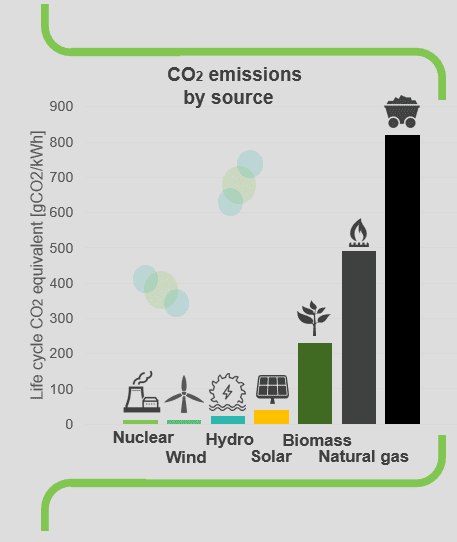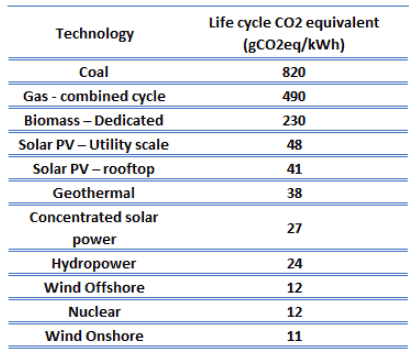 In 2014, the Intergovernmental Panel on Climate Change harmonized the carbon dioxide equivalent (CO2e) findings of the major electricity generating sources in use worldwide. Coal is by far the worst emitter, followed by natural gas, with solar, wind, and nuclear all low-carbon. Hydropower, biomass, geothermal, and ocean power may generally be low-carbon, but poor design or other factors could result in higher emissions from individual power stations.
In 2014, the Intergovernmental Panel on Climate Change harmonized the carbon dioxide equivalent (CO2e) findings of the major electricity generating sources in use worldwide. Coal is by far the worst emitter, followed by natural gas, with solar, wind, and nuclear all low-carbon. Hydropower, biomass, geothermal, and ocean power may generally be low-carbon, but poor design or other factors could result in higher emissions from individual power stations.
Why balanced energy mix?
Generation and consumption must be balanced across the entire grid because energy is consumed as it is produced. Energy is stored in the immediate short term by the rotational kinetic energy of the generators. With the move to more wind and photovoltaics, the inertia in the systems will be reduced. System inertia refers to the kinetic energy stored in large generators’ rotating mass, such as those found in fossil-fuel-based power plants. System inertia is vital for maintaining a stable frequency level. Therefore, a low-carbon balanced energy mix must be based on:
 Variable renewable sources. Renewable energy sources are abundant and have very low or zero carbon emissions, making them environmentally friendly. Variable renewable energy sources are not dispatchable due to their fluctuating nature, such as wind power and solar power. When it’s cloudy or the wind isn’t blowing, the grid needs more energy from other sources. Characteristics of variable renewables include their unpredictability, variability, small size, low running costs, and the fact that they are constrained to a certain location. These provide a challenge to grid operators, who must make sure supply and demand are matched. Solutions include energy storage, demand response, availability of overcapacity, and sector coupling. The higher the share of these sources in the energy mix, the higher the demands on the transmission system and energy storage systems.
Variable renewable sources. Renewable energy sources are abundant and have very low or zero carbon emissions, making them environmentally friendly. Variable renewable energy sources are not dispatchable due to their fluctuating nature, such as wind power and solar power. When it’s cloudy or the wind isn’t blowing, the grid needs more energy from other sources. Characteristics of variable renewables include their unpredictability, variability, small size, low running costs, and the fact that they are constrained to a certain location. These provide a challenge to grid operators, who must make sure supply and demand are matched. Solutions include energy storage, demand response, availability of overcapacity, and sector coupling. The higher the share of these sources in the energy mix, the higher the demands on the transmission system and energy storage systems.- Controllable sustainable sources. Controllable sustainable sources produce low-carbon energy on demand at the request of power grid operators, according to market needs. These sources include nuclear energy, hydropower, biomass, or relatively constant sources, such as geothermal power. Since controllable sustainable sources can follow the grid load, they drastically reduce the demands of variable renewables on the transmission and energy storage systems.
Cost-effective energy storage system. Common examples of energy storage are the rechargeable battery, which stores chemical energy readily convertible to electricity to operate a mobile phone; the hydroelectric dam stores energy in a reservoir as gravitational potential energy. Note that these systems do not produce net energy. Moreover, also energy storage is associated with energy losses, which are around 20%. Energy storage systems are usually very expensive; therefore cost-effective solution includes only peak loads storage. - Cost-effective production of energy carriers. This is probably the most challenging part of a low-carbon economy. The industrial and transport sectors consume more fossil resources than the entire electricity generation sector. In practice, the transition of the industrial sector and transportation to low-carbon primary sources means a transition to hydrogen, electricity, or e-fuels. But their production must be based only on low-carbon primary resources. Because the dominant sustainable sources produce electricity as an energy carrier, in practice, this means that it will be necessary to more than double the electricity generation capacity. Sustainable primary energy sources for residential, industrial, and transportation sectors:
- Solar energy. The primary energy source for solar, wind, hydropower and biofuels is the Sun. Solar energy is the primary sustainable source of energy.
- Nuclear energy.
- Geothermal energy.
- Tidal energy